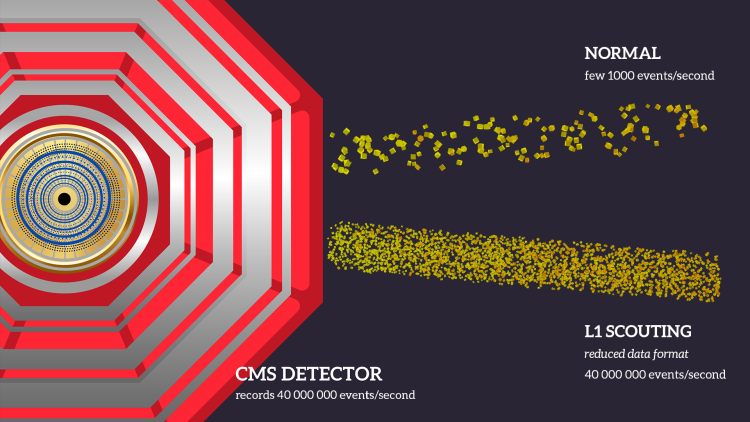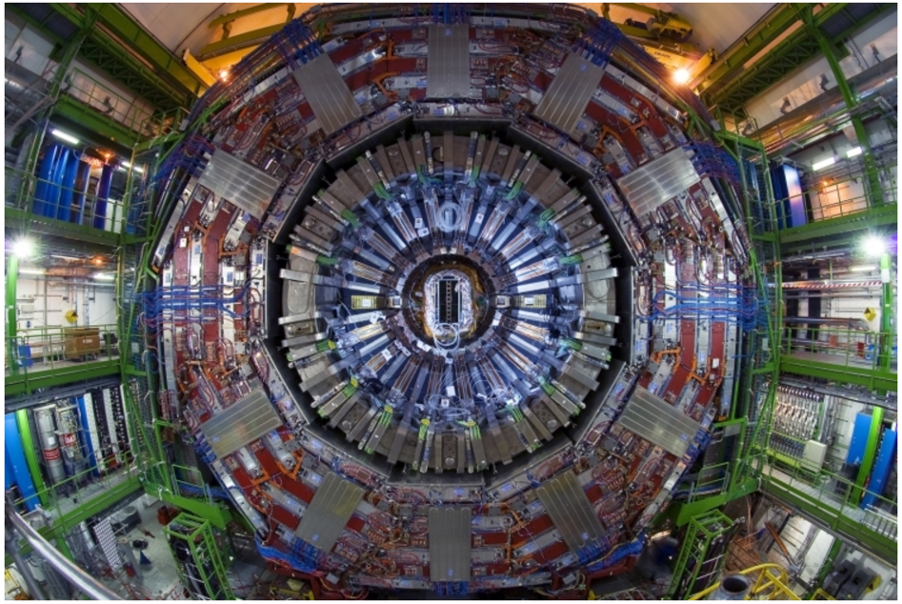
The CMS experiment is utilising a novel technique called L1 Scouting, which allows it to record data from all collisions, without any selection, but in a reduced format. A first pioneer physics result using this data showcases the immense potential of this technology.
Traditional data taking workflows at the LHC experiments rely on a filtering step – called Level-1 trigger – that reduces the amount of data to a manageable level. The Level-1 trigger is implemented in hardware, takes only a few microseconds, and gets rid of more than 99.99% of the events, keeping only the most interesting ones for analysis. But, could the rejected events be hiding new physics? To explore this possibility, the CMS experiment introduced a novel “triggerless” data collection scheme at the Level-1 step of the trigger system. The trigger information, usually used to select events, is now stored to disk. This approach, called Level-1 Scouting, allows us to record the data from all 40 million collision events that are happening each second, in a reduced data format. The figure below illustrates the L1 Scouting workflow.

Above: Overview of the CMS Level-1 Data Scouting system. Collision events first pass the hardware reconstruction of the Level-1 trigger. Traditional data streams rely on a decision of the Level-1 trigger to accept only a fraction of the events for further processing and selection by the High Level Trigger, followed by an offline analysis of the selected events. Level-1 scouting introduces an alternative path, by analyzing events reconstructed by the Level-1 trigger without a preselection.
Recently, the CMS Collaboration utilised data collected using Level-1 Scouting between August and December 2024 to come up with its first result that does not use a trigger.
The result focuses on the search for massive stable charged particles traveling significantly slower than the speed of light. Owing to their slow speed, these particles take a long time to travel to the outer layers of the CMS detector, during which time several other collision events take place. This makes it close-to-impossible to catch them using the regular triggering workflow. Level-1 Scouting, on the other hand, records every single event, making it possible to use correlations between multiple consecutive events to uncover these slow particles.
In the newly released result, the CMS experiment searched for slow muon-like particles taking between two and four bunch crossings to cross the four layers of the muon subdetectors, separated from each other by about 1 metre. No significant excess of data was observed with respect to the background prediction.
“Besides being a crucial proof-of-concept, this result represents the very first physics outcome of the demonstrator of the Level-1 Scouting system, which will reach its full potential with the CMS trigger upgrade for the High-Luminosity LHC,” said Rocco Ardino, from the CMS Scouting team. “This new data collection paradigm is redefining signatures experimentally reachable at the LHC”, added Cécile Caillol, from the analysis team.
Level-1 Scouting opens up multiple avenues for searches that cannot utilise traditional trigger workflows, such as very low mass signatures, and many more. Equipped with these new technologies, CMS is ready to venture further in understanding the Universe than ever before!
Written by: Cécile Caillol, for the CMS Collaboration
Edited by: Muhammad Ansar Iqbal
Read more about these results:
-
CMS Physics Analysis Summary (EXO-25-010): "Search for heavy long-lived charged particles with Level-1 Scouting data from proton-proton collisions at √s = 13.6 TeV (Coming soon)"
-
@CMSExperiment on social media: Bluesky - Facebook - Instagram - LinkedIn - TikTok - Twitter/X - YouTube

